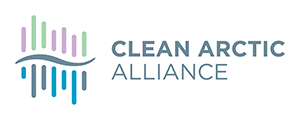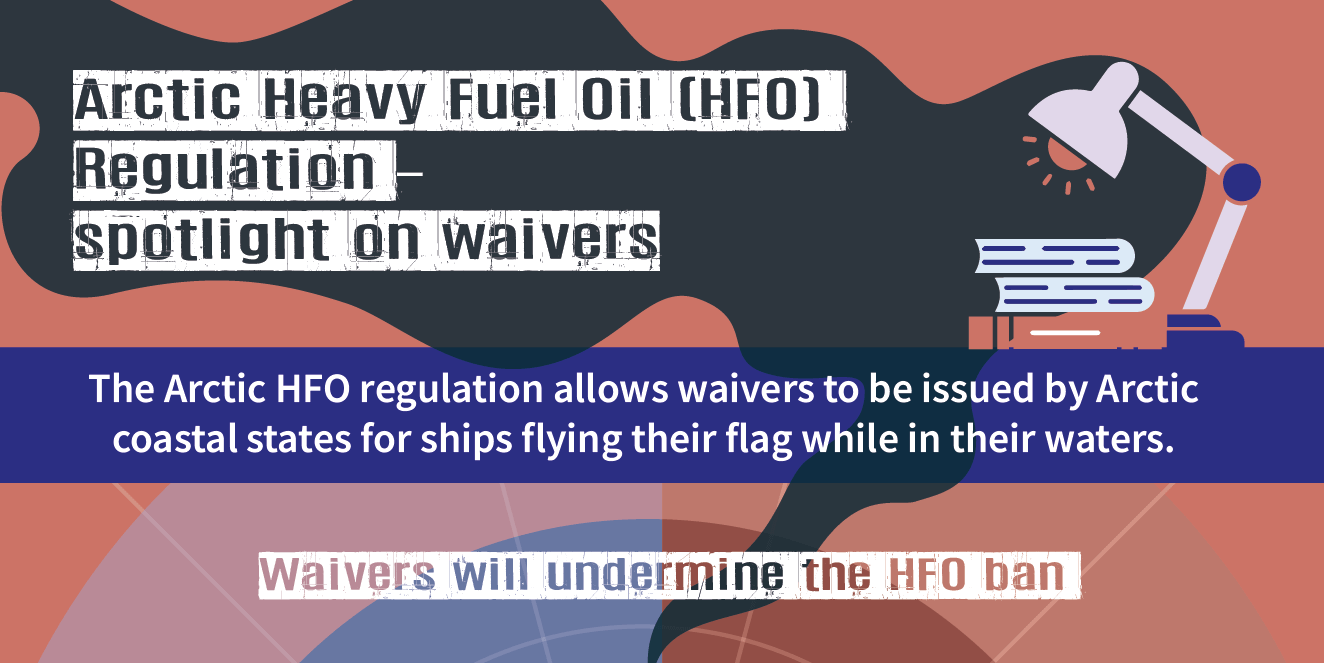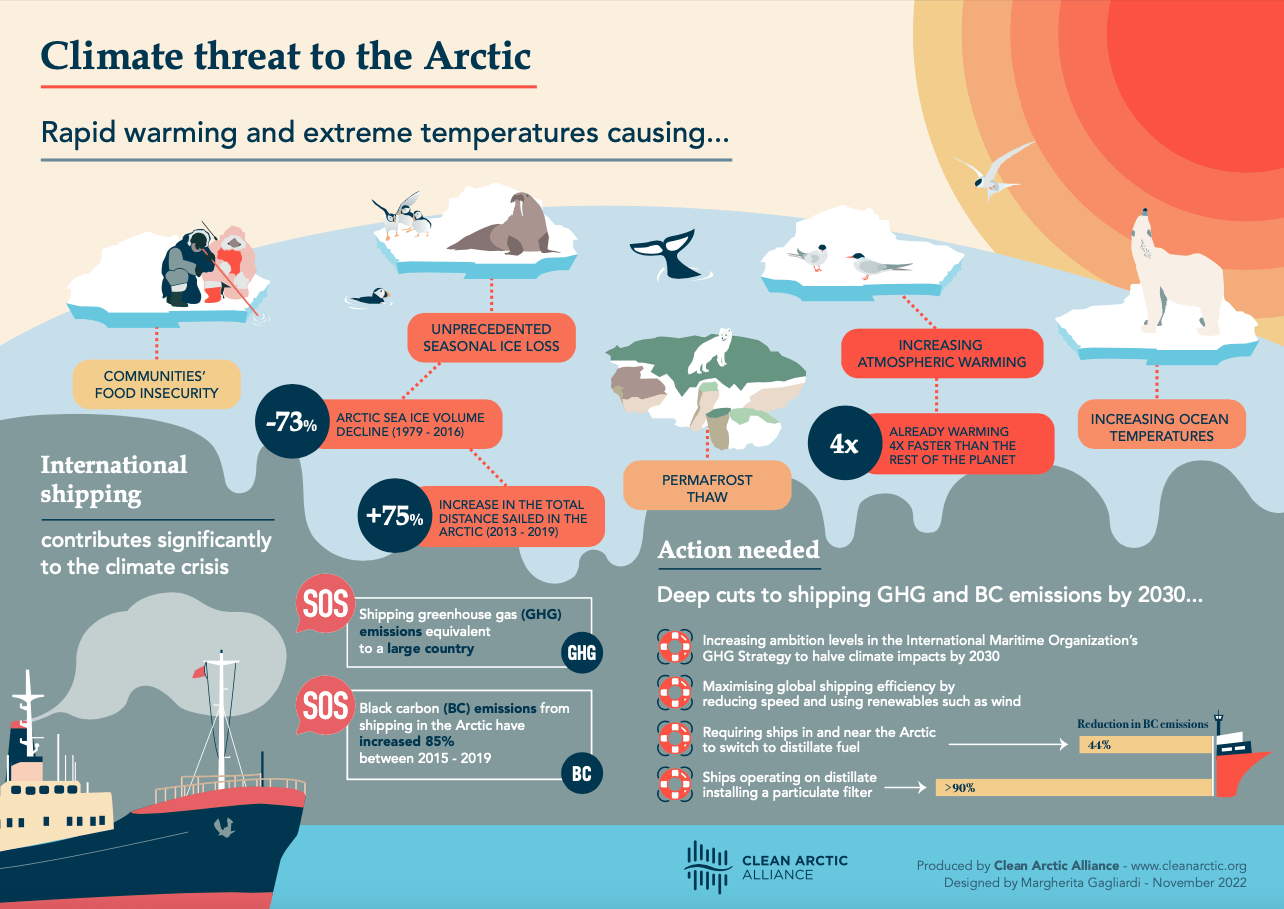
Watch our MEPC 79 briefing video
London, 12 December, 2022:- As a meeting of the International Maritime Organization’s Marine Environment Protection Committee opens today in London (MEPC 79), the Clean Arctic Alliance calls on IMO member states to urgently support regulation of black carbon emissions from international shipping north of 60 degrees North, in order to cut the pollutant’s impact on Arctic snow and ice [1].
When black carbon, a potent climate forcing pollutant with an impact over three thousand times that of CO2 and responsible for around 20% of shipping’s climate impact (on a 20 year basis), is emitted from the exhausts of ships burning fuel such as heavy fuel oil (HFO) and settles onto snow and ice, it accelerates melting and the loss of reflectivity – the albedo effect – which creates a feedback loop that further exacerbates local and global heating. Learn more about black carbon here [2,3] and see MEPC 79/5/5.
“Shipping’s climate impact must halve by 2030 if global heating is to be kept below the Paris Agreement’s limit of 1.5 degrees, and action on black carbon is essential if the industry is to reach this objective”, said Dr Sian Prior, Lead Advisor to the Clean Arctic Alliance, made up of 20 not-for-profit organisations working to persuade governments to take action to protect the Arctic, its wildlife and its people.
“Reducing the impact of black carbon on Arctic snow and ice would have a rapid and dramatic reduction in the impact of shipping emissions on the planet’s climate – this is why action in the shipping sector to reduce black carbon emissions can and should start immediately, by simply switching to cleaner fuels and installing particulate filters”, she added. See MEPC 79/7/20.
“The IMO can regulate and reduce black carbon emissions by amending MARPOL Annex VI to require ships operating in and near to the Arctic (north of 60 degrees North) to use distillate or other alternative cleaner fuels”, said Prior [4]. See MEPC 79/5/5 and MEPC 79/5/6].
Currently, black carbon emissions from ships are completely unregulated by the IMO. While the IMO’s sulphur dioxide (SOx) regulation arguably regulates black carbon, it not designed to do so, and only achieves black carbon reductions if the SOx limit is reached by moving to cleaner fuels (and not by using ultra low sulphur fuels or using heavy fuels with scrubbers (exhaust gas cleaning systems or EGCS)) [5].
“In addition to a new black carbon regulation, the Clean Arctic Alliance supports the adoption by IMO member states, during MEPC 79, of the proposed Mediterranean Sea Emission Control Area (ECA) for Sulphur Oxides and Particulate Matter and calls on IMO member states to support further ECAs, the creation of which will contribute to the future reduction of black carbon emissions impacting the Arctic”, said Andrew Dumbrille, Clean Arctic Alliance advisor [6]. See MEPC 79/3/6.
“For states such as Canada and the US, extending their ECAs to the Arctic would provide comprehensive protections for all communities, including Indigenous communities, and especially to ice covered areas,” continued Dumbrille. “In addition, designation of ECAs in all European waters would be valuable to reduce black carbon reaching the Arctic from further south.”
Heavy Fuel Oil Ban (HFO)
“The Clean Arctic Alliance calls on member states to support the removal of the IMO loophole which allows the five Arctic coastal states to issue waivers for state-flagged vessels in their waters to circumvent the IMO’s heavy fuel oil ban – removing this loophole will increase the effectiveness of the ban in protecting the Arctic, from both heavy fuel oil spills, and black carbon emissions”, said Dumbrille.
To remove this loophole, IMO member states must support an amendment to Regulation 43A of MARPOL Annex I by removing clauses 43A.4 and 43A.5, in order to increase its effectiveness at protecting the Arctic [7]. See MEPC 79/14/1.
If heavy fuel oil is spilled in cold polar waters, it is likely to break down very slowly, and prove almost impossible to clean up. A HFO spill would have long-term devastating effects on Arctic indigenous communities, livelihoods and the marine ecosystems they depend upon. As sea ice melts and opens up Arctic waters further, even larger non-Arctic state flagged vessels running on HFO are likely to divert to Arctic waters in search of shorter journey times, greatly increasing the risks of HFO spills [8].
Following five years of advocacy and pressure, in June 2021 the International Maritime Organization finally adopted a ban on the use and carriage of heavy fuel oil in the Arctic [8].
However, the ban adopted by the IMO’s Marine Environment Protection Committee is far weaker than was required, leaving the Arctic, its Indigenous communities and its wildlife facing the risk of a HFO spill for another decade.
Scrubbers
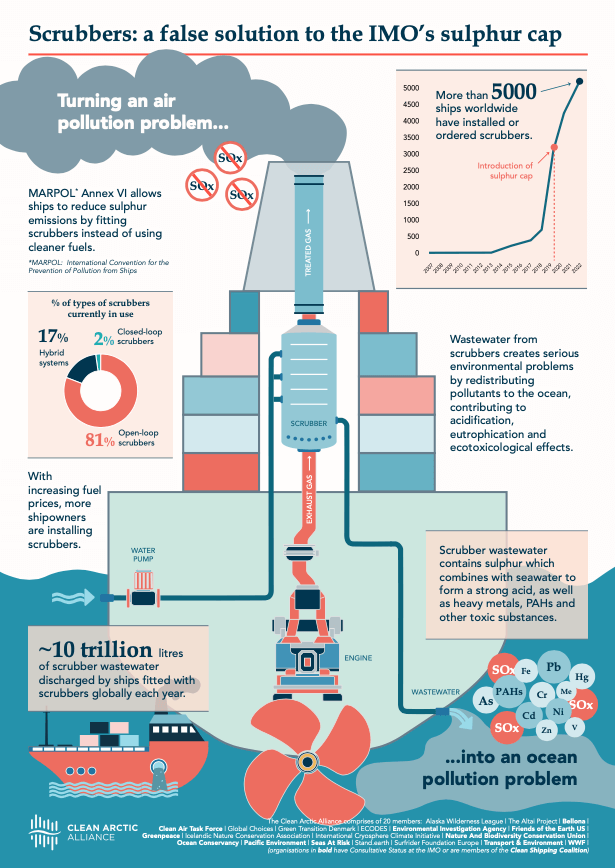
In recent years, efforts have been made to move shipping away from heavy high-sulphur fuels to cleaner distillate fuels by lowering the permissible sulphur content of fuel oils, however the fuel and shipping industry have continued to use dirty heavy fuels by blending and treating them to reduce the sulphur content, or by installing an exhaust scrubber to remove the sulphur at the “end of the pipe” and dump the wastewater into the ocean. The use of scrubbers results in significant ocean pollution.
When considered in the context of UNCLOS, scrubber discharges are inconsistent with the mandate to protect and preserve the marine environment. Discharges are also inconsistent with UNDRIP (United Nations Declaration on the Rights of Indigenous People) and the rights of Indigenous communities to exercise their rights to livelihood and culture.
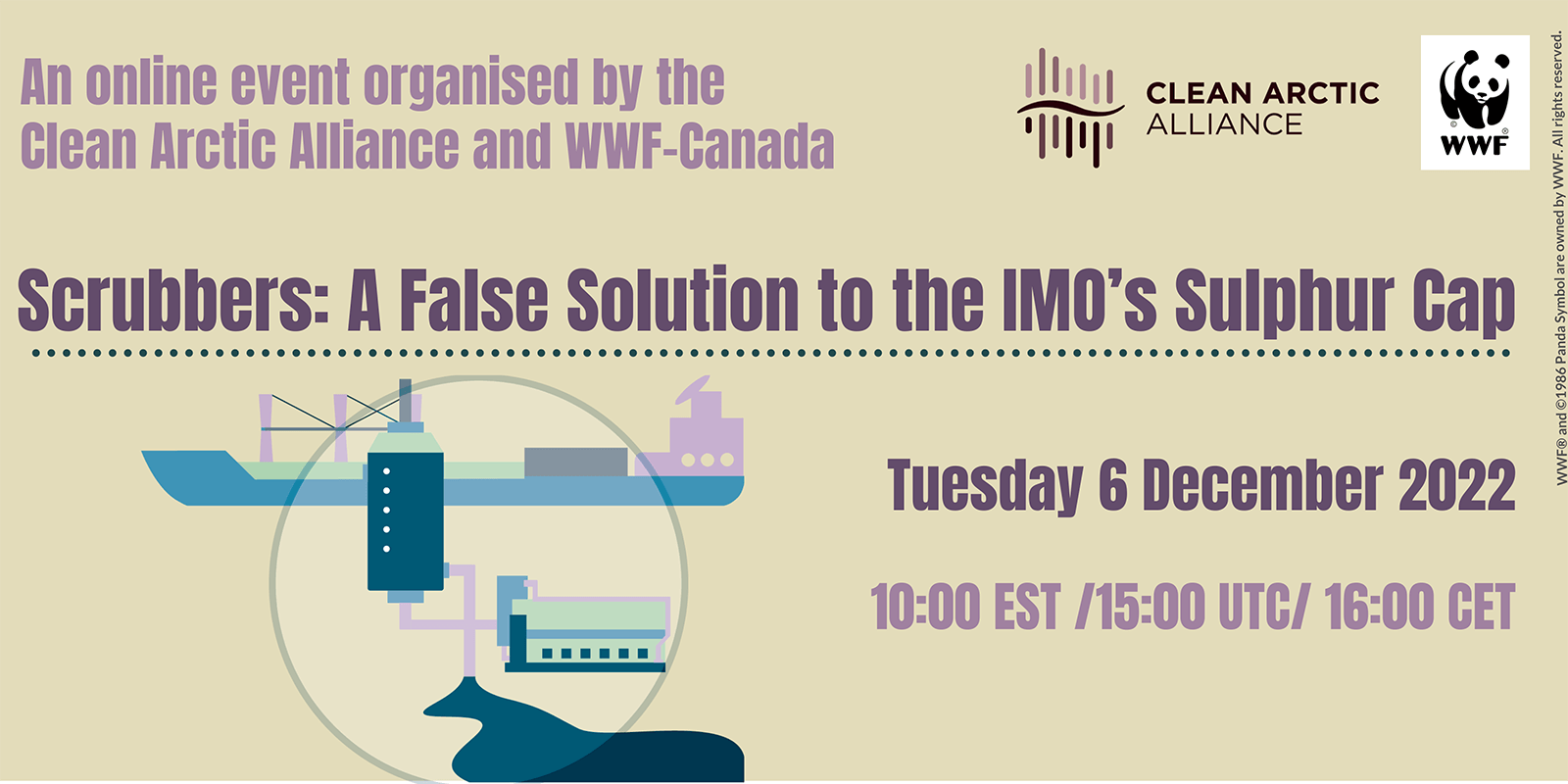
“IMO member states must support a ban on the use of scrubbers by the shipping sector, and support the need for consistency between the United Nations Convention on the Law of the Sea (UNCLOS) and the choice of compliance mechanisms to meet the low sulphur content of fuel oil requirements; and until a global ban is in place, lead domestic action to ban scrubbers under obligations to UNCLOS”, said Eelco Leemans, Clean Arctic Alliance Technical Advisor [10].
Climate Tipping Points
“It is crucial that the IMO and its member states listen clearly, heed and act upon the dire warnings coming from climate vulnerable nations and Indigenous communities”, continued Prior. “IMO Member states must also ensure that climate vulnerable nations and Indigenous communities are fully involved and enabled to participate in all aspects of the shipping industry – including its impact on the global climate”.
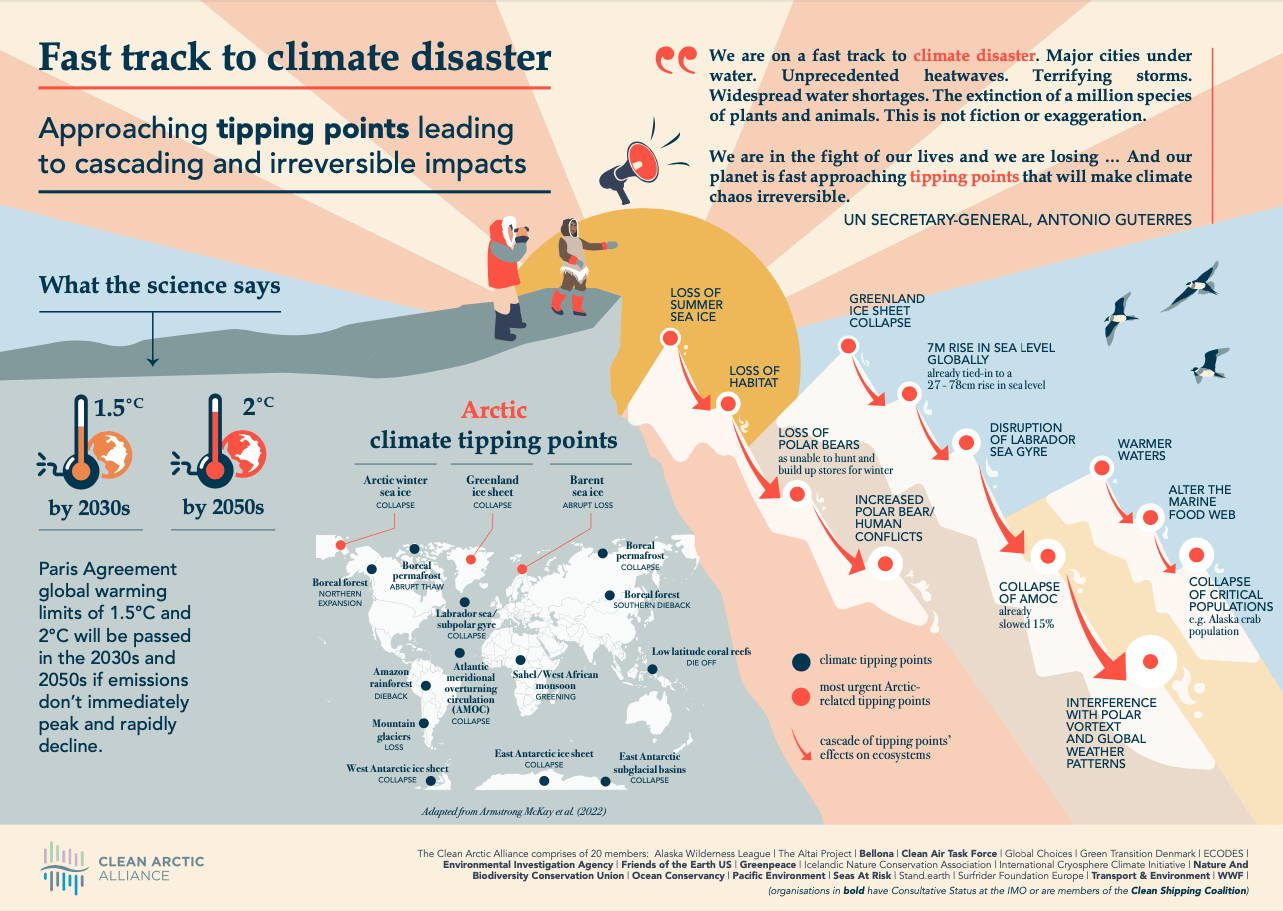
“The IMO must also join the work to enhance collaboration between UN agencies and other national and international agencies to speed up climate action. While the United Nations has declared a climate emergency, the IMO is cruising along as if oblivious to the challenges that must be addressed and the opportunities that must be seized this decade” [11]. See MEPC 79/7/20.
“The Earth is nearing dangerous tipping points – every industry, including shipping, must act to steer us on to a safe course. For shipping to play its part, IMO member states must bring the levels of ambition in the Organization’s initial GHG Strategy unambiguously into line with that of the Paris Agreement. To achieve this, the IMO must include a target of halving ship climate impacts by 2030 and full decarbonisation of shipping well before 2050”.
“This requires that the IMO support deep cuts to black carbon emissions from ships in and near the Arctic, and crucially integrate black carbon into all IMO climate measures, including the carbon intensity indicator, so regulations target not just CO2 but CO2 equivalent including black carbon.”
The IMO’s Carbon Intensity Indicator (CII) is a way of measuring the efficiency of how the shipping sector moves cargo or people [12]. It is expressed in terms of grams of CO2 emitted per cargo-carrying capacity, and nautical mile. It is designed to make ships start reducing their CO2 emissions this decade, but as it currently stands, the initial reductions required will mean very little changes. At the moment the CII doesn’t include black carbon – only CO2, and the level of ambition in the indicator needs to be strengthened.
“Black carbon emissions must be integrated into all IMO climate initiatives with measures targetting not just CO2, but CO2 equivalents including black carbon, methane and NOx”, concluded Prior.
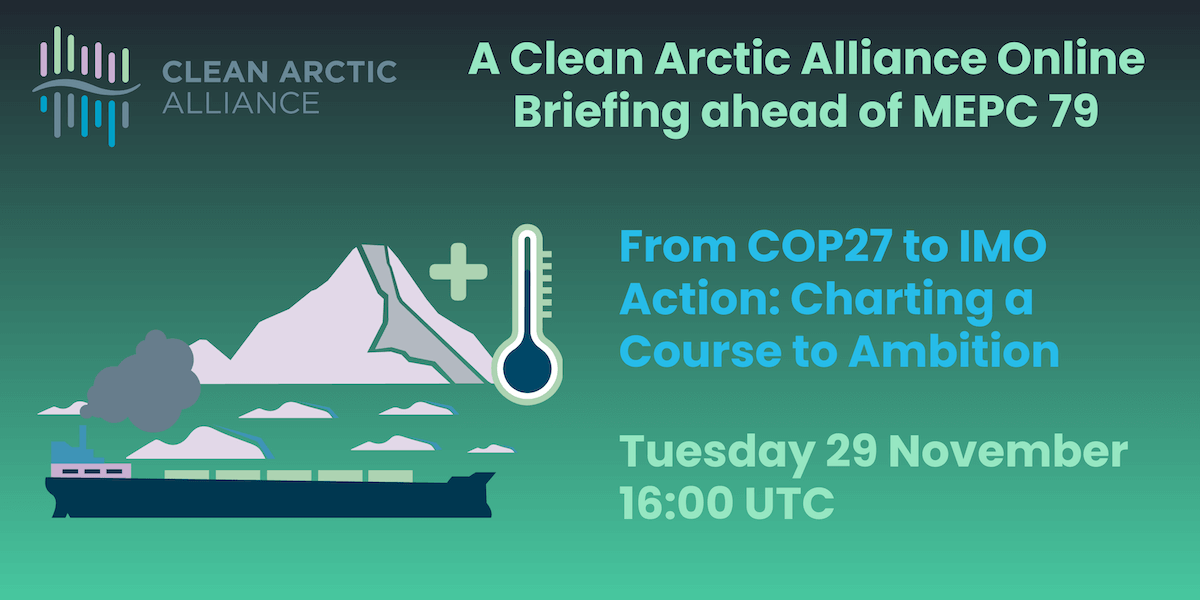
ENDS
Contact:
Dave Walsh, Communications Advisor, [email protected], +34 691 826 764
Notes:
RELEVANT AGENDA ITEMS:
Agenda Item 3 – Consideration and Adoption of Amendments to Mandatory Instruments (ECAs)
Agenda Item 5 – Air Pollution Prevention (scrubbers, Annex VI Black Carbon)
Agenda Item 7 – Reduction of GHG Emissions from Ships (Tipping Points, EEXI, Revision of IMO GHG Strategy))
Agenda Item 14 – Any Other Business (Annex 1 HFO Ban)
[1] Marine Environment Protection Committee (MEPC) – 79th session, 12-16 December 2022
https://www.imo.org/en/MediaCentre/MeetingSummaries/Pages/MEPC-79-Preview.aspx
[2] International Council on Clean Transportation, Black Carbon Emissions and Fuel Use in Global Shipping, 2015
https://theicct.org/publication/black-carbon-emissions-and-fuel-use-in-global-shipping-2015/
Clean Arctic Alliance: Black Carbon
https://cleanarctic.org/campaigns/the-arctic-climate-crisis/black-carbon-in-the-arctic/
MEPC 79/5/5: Amending MARPOL Annex VI to Reduce the Impact on the Arctic of Emissions of Black Carbon
https://cleanarctic.org/2022/10/07/mepc-79-5-5-amending-marpol-annex-vi-to-reduce-the-impact-on-the-arctic-of-emissions-of-black-carbon/
The Guardian, 10 April 2022,‘Black carbon’ threat to Arctic as sea routes open up with global heating
https://www.theguardian.com/environment/2022/apr/10/black-carbon-threat-to-arctic-as-sea-routes-open-up-with-global-heating
TradeWinds, 16 November 2022: At COP27, a bid to lift shipping’s black carbon emissions up the agenda
https://www.tradewindsnews.com/esg/green-seas-at-cop27-a-bid-to-lift-shipping-s-black-carbon-emissions-up-the-agenda/2-1-1354678
[4] IMO: Prevention of Air Pollution from Ships
https://www.imo.org/en/OurWork/Environment/Pages/Air-Pollution.aspx
MEPC 79/5/5: Amending MARPOL Annex VI to Reduce the Impact on the Arctic of Emissions of Black Carbon
https://cleanarctic.org/2022/10/07/mepc-79-5-5-amending-marpol-annex-vi-to-reduce-the-impact-on-the-arctic-of-emissions-of-black-carbon/
MEPC 79/5/6 – Arctic HFO ban is not a Black Carbon control measure
https://cleanarctic.org/2022/10/21/mepc-79-5-6-arctic-hfo-ban-is-not-a-black-carbon-control-measure/
[5] Clean Arctic Alliance, Scrubbers
https://cleanarctic.org/campaigns/arctic-biodiversity/sulfur-oxides-and-scrubbers/
Scrubbers Webinar: A False Solution to the IMO’s Sulphur Cap
https://cleanarctic.org/2022/12/06/scrubbers-a-false-solution-to-the-imos-sulphur-cap/
MEPC 79/5/3: EGCS and UNCLOS
https://cleanarctic.org/category/publications_en/imo-papers/#:~:text=MEPC%2079/5/3%3A%20EGCS%20and%20UNCLOS
[6] 14 June 2022, IMO body grants green light to the proposal on curbing emissions from ships in the Mediterranean
https://www.unep.org/unepmap/news/news/imo-body-grants-green-light-joint-proposal-curbing-emissions-ships-mediterranean
MEPC 79/3/6: Emission Control Areas (ECAs) – work in progress for cleaner air and healthy coastal communities
[7] MARPOL Annex I – Prevention of Pollution by Oil
https://www.imo.org/en/OurWork/Environment/Pages/OilPollution-Default.aspx
IMO, 17 June 2021, Further shipping GHG emission reduction measures adopted
https://www.imo.org/en/MediaCentre/PressBriefings/pages/MEPC76.aspx
MEPC 79/14/1: Proposal for a revision to MARPOL Annex I regulation 43A on the special requirements for the use and carriage of oils as fuels in Arctic waters
https://cleanarctic.org/2022/10/07/mepc-79-14-1-proposal-for-a-revision-to-marpol-annex-i-regulation-43a-on-the-special-requirements-for-the-use-and-carriage-of-oils-as-fuels-in-arctic-waters/
[8] Clean Arctic Alliance, Heavy Fuel Oil
https://cleanarctic.org/campaigns/arctic-biodiversity/heavy-fuel-oil-free-arctic/
[9] IMO and Arctic States Slammed for Endorsing Continued Arctic Pollution
https://cleanarctic.org/2020/11/20/imo-and-arctic-states-slammed-for-endorsing-continued-arctic-pollution/
[10] United Nations Convention on the Law of the Sea
https://www.un.org/depts/los/convention_agreements/texts/unclos/unclos_e.pdf
[11] UNEP: Facts about the Climate Emergency
https://www.unep.org/facts-about-climate-emergency
UN, 4 April 2022: Secretary-General Warns of Climate Emergency, Calling Intergovernmental Panel’s Report ‘a File of Shame’, While Saying Leaders ‘Are Lying’, Fuelling Flames
https://press.un.org/en/2022/sgsm21228.doc.htm
MEPC 79/7/20: Climate science, cascading tipping points, the Initial IMO GHG Strategy, and urgent action on shipping to reduce climate risks
https://cleanarctic.org/2022/10/07/mepc-79-7-20-climate-science-cascading-tipping-points-the-initial-imo-ghg-strategy-and-urgent-action-on-shipping-to-reduce-climate-risks/
[12] 1 November 2022
Rules on ship carbon intensity and rating system enter into force
https://www.imo.org/en/MediaCentre/PressBriefings/pages/CII-and-EEXI-entry-into-force.aspx
See also: https://www.imo.org/en/MediaCentre/PressBriefings/pages/MEPC76.aspx
About the Clean Arctic Alliance
Made up of 20 not-for-profit organisations, the Clean Arctic Alliance campaigns to persuade governments to take action to protect the Arctic, its wildlife and its people.
Members include: The Altai Project, Alaska Wilderness League, Bellona, Clean Air Task Force, Green Transition Denmark, Ecology and Development Foundation ECODES, Environmental Investigation Agency, Friends of the Earth US, Global Choices, Greenpeace, Iceland Nature Conservation Association, International Cryosphere Climate Initiative, Nature And Biodiversity Conservation Union, Ocean Conservancy, Pacific Environment, Seas At Risk, Surfrider Foundation Europe, Stand.Earth, Transport & Environment and WWF.
More more information visit https://www.cleanarctic.org/
